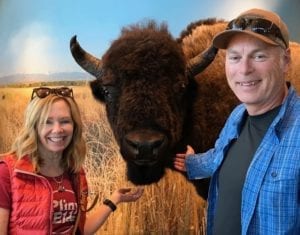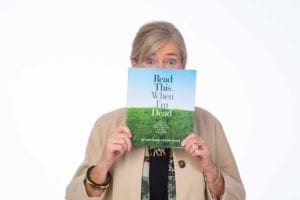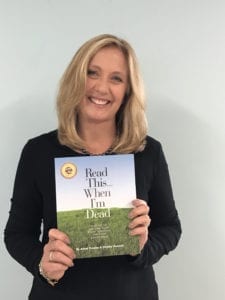NEW~ Fan55 Coffee Chat FB LIVE Wednesday 8am Central on Facebook. We take a weekly dive into an important topic. Click here for the videos and read the Coffee Chat Notes below.
VOL. 9 EXERCISE: WHY, WHAT & HOW TO GET STARTED
Did you know that physically inactive people can lose 3-8% of their muscle mass each decade after 30 years old? And the rate of decline is even higher after 60! (National Institute of Health). Plus, as our body ages, fat mass increases which changes our body composition. Bone density decreases, joint stiffness increases. And hormones are changing that become less efficient in using our body fuel, protein.
Our bodies change as we live another day. Heredity plays a part, yet LIFESTYLE is a major factor in aging.
WHAT can we do? Activity & Exercise, Living in a safe environment and Eating healthy helps our body.
Today our focus is Exercise. (7 Strength, Balance & Flexibility Exercises, National Institute on Aging 13 min). Regular aerobic exercise protects muscles, Restitance exercise strengthens muscles, Balance exercises cuts the risk of fall injuries, and Flexibility exercises helps our movement and joints (6 Flexibility Exercises, National Institute on Aging 18 minutes).
The Mayo Clinic recommends 150 minutes of moderate aerobic exercise or 75 minutes of vigorous activity plus twice per week strength training.
HOW to get started? You are never too old or out of shape. You may need to get medical clearance or get a program designed specifically for your needs. Wear comfortable clothes and good tennis/running shoes. Set your Goals. Track your progress. If it helps the motivation or fun factor – grab a pal, get a trainer or join a gym.
For additional information: 25 Again? How Exercise May Fight Aging, 2 Forms of Exercise are the Best Way to Starve Off the Effects of Aging, Exercise Basics for Older Adults
COFFEE CHAT LIVE VOL. 8 POST SHUTDOWN JOB SEARCH
Even though we’ve experienced advances fighting agism, COVID-19 has painted us as “older and high risk.” This feels like an additional challenge in a post shutdown job search.
Because of the virus, about 30 Million people have lost their jobs. Many in the retail business (25% of retail workers are 55+; about 4.4Million) and 40% of all 55+ workers have to work. Our unemployment rate has gone from 3.4% to about 20%. The dynamics have changed.
What does postshut down look like for working folks? Most experts agree that there will be an Employee/Employer shuffle. There will be company winners and losers. Companies gaining strength include: Target, FedX, Walmart, Facebook, Zoom, Apple, Microsoft, Amazon. Categories include Telehealth, streaming and working from home (WFH).
So what is a 55+ to do? 1) Safety is #1. If you are weary of your health, follow the cdc and your area guidelines. 2) If you are ready and able to work, let’s do some prep work starting with the jobs that you are interested in performing. Check sites like Indeed, Career Builder, etc. for jobs that are available. Note the job description Duties and Responsibilities and see what employers are looking for in today’s market. Then evaluate your skills compared to the market need.
Do your past skills transfer into day’s needs? Update and de-age your resume. If you need help, seek it from peers, local employment agencies, job-hunting clubs, or a career coach.
It appears that digital skills will be quite valuable. If you need to improve yours, get training at Coursera, SCORE, SeniorPlanet, Udacity, LinkedIn Learning or others online. Participate in free webinars to stay up-to-date with your industry. They are plentiful on Linkedin or Facebook. Yes, they want to sell you something (and they’ll send you multiple follow-up emails) but if you aren’t interested in buying, simply gain the info they are presenting and move on.
Update your LinkedIn profile. 95% of recruiters use them! Update your photo, summary and skills. Add new classes and training that you completed during the shutdown. Use keywords for the jobs that you seek.
For additional information: CNBC The US Economy Has Been Hit Hard by the Coronavirus Pandemic-Here’s what it’s like for job seekers, Retail Workers in their 60s, 70, and 80s say They are Worried, LinkedIn Most In-Demand Skills
COFFEE CHAT LIVE VOL. 7 ADVANCE HEALTHCARE DIRECTIVE
Advance Healthcare Directive or a Living Will is a document for planning your future medical care. About 75% of us DON”T have one. Each state has their own form (the state in which you reside). Click here for the forms by state. Most state forms include your selected Healthcare Power of Attorney who is the person you identify to speak for you pertaining to the Advance Healthcare Directive. (NOTE: This is about your Healthcare NOT about your Financial Documents that might include your Will, a Living Trust or a Revocable Trust.) The Advance Healthcare Directive is a signed and notarized document.
An Advance Healthcare Directive is so important, one of the first things medical professionals will ask you is if you have one. And frightingly, 25% of recent COVID-19 patients entering the hospital can’t speak due to shortness of breath (CNBC, As Coronavirus Continues to Spread, Doctors Urge Americans to get a Living Will) Most importantly, an Advance Healthcare Directive helps your loved ones manage your health when you can not.
An Advance Healthcare Directive is: a Planning and Communication Tool; Covers Multiple Topics and Helps your Loved ones because your have communicated your values and preferences prior to the fog of sickness. You’ll want to add it to your medical records, possibly keep a copy in your safety deposit box and a digital copy on your handheld device.
Coffee Chat LIVE vol. 6 The New Longevity
In week 6, we explore the New Longevity: Why it is Important and How Can You Make the Most of It.
The New Longevity: Living Longer. Did you know that almost 1/3 of Americans are 55-and-better? And 10,000 Baby Boomers turn 65 every day? We are living longer. Life expectancy today is in the mid 80’s whereas in 1900 it was 47 years old. Our post-retirement can last 20-40 years!
Staying Healthier: “Health is the New Wealth” In the old days, retirement meant slowing down, taking it easy and rocking in a rocking chair. Today, we embrace being active, engaged and physically (2.5 hours of moderate exercise each week; 7,500-10,000 steps per day) & menatally fit. We do our best to eat healthy – fruits & veggies, lean protein, less sugar and to boost immunity by eating citrus fruits, broccoli, berries, spinach and drinking green tea.
Digitally Connected: About 75% of people ages 65+ are internet users and screen times continue to increase. Recently, because of COVID-19, there has been a rise in Mmedicine (mobile medicine) or Telehealth as professional appointments are taking place online. Expect more of this and pat yourself on the back for being digitally savvy.
Why is the New Longevity important to me? We have no expiration date. Attitudes are changing around work, relationships and purpose. Opportunities abound, however Challenges remain. Age discrimination at work, although illegal takes the form of not being chosen for training on new equipment, not being put on the new product team, down sizing or re-organizing. And our culture is still youth focused. Age may be looked upon as a negative. With COVID-19, I believe there will be a shuffle of workers and employers once the economy gets re-started.
How Can I Make the Most of the New Longevity? We need to stay in the game. Socially & Physically active. Informed & Empowered. Relevant & Vibrant. This generation of Seniors will leave a lifestyle legacy.
Coffee Chat LIVE vol. 5 Mental Wellness
For our chat this morning, we are talking about Mental Wellness, meaning the ability to cope with life’s ups & downs especially as we navigate aging. (This is a general conversation including hints & tips, yet should not be a substitute for professional help.)
- Lives will change. Retirement, second act, encore career, downsizing, body and family changes. The key is to have a purpose (Purpose in Life and Positive Health Outcomes Among Older Adulds by Musich, Wang, Wicker). People with a purpose are less stressed and more engaged which leads to better cognitive and physical health.
- We are all going through this, so talking with your friends, family and associates may help you feef better. It gets it off of your heart and when you hear yourself say it outloud, you actually listen to yourself and evaluate your words from a new prospective.
- Seek professional help, if needed – your physician, local aging organizations, a life coach or other professionals.
- Take time to envision what you want this time of your life to be. Make a plan. Consider relationships, lifestyle, finances, housing and social network. We trust technology will be in your vision.
- Physical Activity, Brian Workouts and Sleep are important to your mental wellness. Add these to your plan to better navigate longevity.
- Eat & Drink wisely. More info at Healthy Living Can Delay Alzheimer’s by Ted Knuston, forbes.com
- Whether you have a second act career, a serious hobby or just having fun, do what you like to do.
- Relax – schedule silence (5 Health Benefits of Being Silent for Your Mind and Body), meditate (The Many Benefits of Meditation for Older Adults by Heidi Godman), daydream. Take a vacation or simply enjoy a conversation with a friend.
Fan55 Coffee Chat vol. 4 Aging in Place
Over 80% of people ages 65+ want to age in place, so let’s take a few minutes to chat about it. We divide the conversation into three areas: Considerations, Planning Steps & Actions.
Considerations: Take into account your general health and financial situation. Consider the infastructure of where you are going to age – are family & friends close? doctors? church? shops? restaurants?
You’ll want to consider technology, as well. Telehealth, Mmedicine, Wearable, In-home monitors and many more tech gadgets will help you age in place.
Planning Steps: Evaluate your current dwelling. Will you upsize, downsize, or retrofit your current home? Experts agree that 1-Floor living offers benefits. Do your research. Consder your timeline. If you choose aging in place then you may need to adjust your home; you may also want professional advice. There are Occupational Therapists with Certifications in Environmental Modifications or professionals with Executive Certification in Home Modifications or CAPS (Certified Aging in Place Specialists).
Action Steps: Safety, especially NO FALLS are key. Your home exterior should be well-lit with good signage (Uber driver and first-responders). Sidewalks and pathways need to be even and level. Your interior should have excellent lighting, as well. Doorways that are 36″ wide are wheel-chair friendly and lever door handles are recommended.
The bathroom is where 80% of falls occur (National Institute on Aging). Bathroom upgrades include Non-slip shower, tub and floor surfaces, hand-held shower heads, low-rise or no-step showers, grab bars and comfort toliets (17″-19″ high for easy on, easy off).
We hope this has been helpful to your aging in place decision. See you next time at Fan55 Coffee Chat LIVE Wednesday 8am Central. Thanks for joining us!
Fan55 Coffee Chat Vol. 3
Online Safety is especially important since about 70% of Seniors are online and screen time is growing. Plus telemedicine and medical wearables/feedback will probably outlive and expand after the COVID crisis. We are all learning. And about the time we think we have learned our lessons, the scammers come up with new tricks. So let’s discuss the basics: 1) Don’t click or respond to an email or text offering to fast track your COVID Stimulus Check. The secure information is on the homepage of irs.gov.
2) Don’t send money from an online request. Don’t click on emails, texts or live links that don’t seem quite right. If you get a message from your bank (or a bank); DON’T open it unless you know it is safe. If you don’t know, simply call your banker and ask if they are needing you for something. Another variety of this scam is the headline “Is this you in the video? or “Here’s a new app for you.” Again, don’t open them. If you know the sender, initiate a correspondence to them on a different platform and assume they have been hacked.
3) Use strong passwords and change them every 6 months. Write them down in your own passcode notebook (free) or use an online app like Dashlane, Lastpass or 1Password.
4) Use 2-step verification. Once you set this up for your accounts, if a provider doesn’t recognize you, they’ll send you a code via by text or email and you’ll type in the code to get into your account.
5) Be careful with the information you provide or share on social media. Don’t reveal things that might be part of a current or future password. Don’t tell the world all of the details about your grandchildren or when you’ll be out of your house for an extended vacation. Remember there are bad actors out there.
6) Know the source of something you are reading, liking or sharing on social media. Unfollow anything you don’t trust.
Here are additional resources for Online Safety: CNBC’s How Retirees can Avoid Mounting Cybersecurity Threats, Internet Safety for Seniors, Protect Seniors Online, AARP’s Strategies for Staying Safe and Secure Online,
Fan55 Coffee Chat Vol. 2 Creativity and Healthy Brain Aging
Creativity means our brain is open to new ideas and we have a flexible attitude. Creativity helps to starve off brain/cognitive decline. Plus creative activities reduce depression and improves vitality and quality of life (Creativity and Successful Brain Aging: Going with the Flow by Susan Krauss Whitbourne Ph.D, psychologytoday.com).

3 Steps to Train our Creative Brain: 1) Pick the non-obvious choice 2) Look at something through another’s eyes – like a box which for a child might be a fort, a shield or a sled down a muddy hill 3)Discard what you know by seeking new facts and statistics then pause and reconsider what you know (Science Says We Get Less Creative as We Age by Rohini Venkatraman, inc.com).
Apply Your New Creativity


Personal Creative Activities: Reading, Writing (like Matt & Karen Smith authors of Dear Bob and Sue series), Songwriting, Cooking, Doing Puzzles & Brain-teasers, Playing games or cards. There are now Guided Journals that make writing and recording important information quite easy. An example is the Read This… book series by Annie Presley & Christy Howard.
Musical Creative Activities: Listening, Singing, Learning to play an instrument are TOTAL Brain workouts that are associated with reducing anxiety, blood pressure and pain levels (Keep Your Brain Young with Music, hopkinsmedicing.org)

Spatial Arts: Drawing, Painting, Sculpting, Ceramics, Glass-blowing, Scrapbooking, Organizing your favorite collection
Dwelling Creative Activities (maybe these are chores or projects, yet let’s retrain our brain to call them “creative” outlets): Dream & draw out that new room addition, Re-decorate a room-paint, re-arrange, add new curtains, Plan then Plant your new garden, Clean and re-organize the garage
What’s Your Creative Outlet???